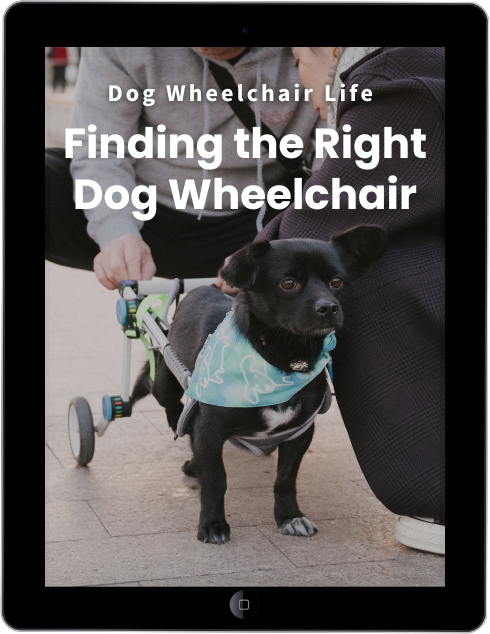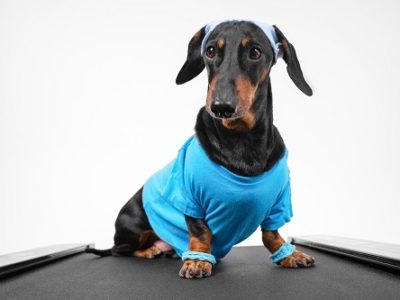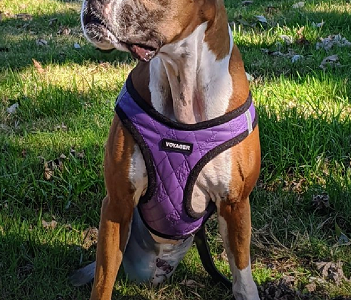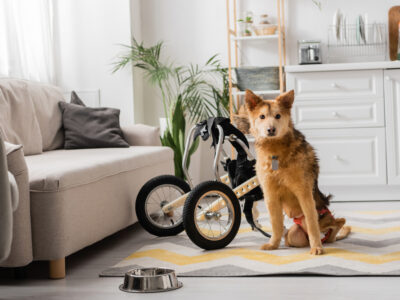
An event took place several years ago that made me realize how easy it is for dog birth defects to happen. A puppy’s body is complicated and fragile. It only takes one small anomaly to change their future, forever.
The incident started with a call about a 9-week-old Labrador retriever who was being considered for the Lucky Dog television show. The program highlighted the work of dog trainer, Brandon McMillan, who transformed dogs with a rough start in life, into ideal family pets.
This puppy seemed to have a birth defect in his hind legs. They stuck straight out as if they were locked in place. It made it nearly impossible for the puppy to learn how to walk. A friend of McMillan’s contacted me about recommending a specialist. He suspected the dog had a birth defect called Straight-leg Syndrome.
I reached out to Cathy Erwin from Walkabout Harnesses for help. She made some recommendations from her experience as a canine physical therapist and I followed up with a call to the Lucky Dog show.
Unfortunately, we never heard what happened to the little Lab, but it made me curious about other dog birth defects that keep puppies from walking. I found five that are pretty common.

Ask & Discover
Get personalized content recommendations and answers drawn from our website. Simply type your question or topic of interest, and our AI assistant will help you find relevant articles, tips, and insights. You can also have a natural conversation to explore topics in more depth.
Straight-leg Syndrome (SLS)

SLS goes by two names Straight-leg syndrome and Straight Leg Shepherds. That’s because German shepherds were the first breed identified with this birth defect.
Affected puppies have stiff hind legs that don’t bend normally. They have limited movement in their muscles and deformities in the bones of their rear legs and hips.
To get an idea about how these puppies look, most photos show them sitting on their hind end with their legs sticking out straight in front of them.
It’s believed the disability is due to a problem with adductor muscle in the thigh. In the case of SLS, the adductor muscle pulls the legs tightly together instead of allowing them to be flexible.
There’s no clear answer about the cause of this birth defect, but there are two theories. Researchers at North Carolina State University think it’s a “neurologic mutation deformity.” That means, the condition starts in the central nervous system.
Other researchers think the SLS comes from a single-cell parasite called Neospora Caninum. This parasite is known to cause aborted pregnancies in dogs, cattle and other animals.

eBook
Find The Right Dog Wheelchair For Your Pet
Your dog has a mobility problem, and you want to buy a wheelchair. But do you know what kind of cart will work best for your dog’s individual needs? After a decade of teaching pet owners how to make the right choice, I put the information into an eBook!
Hutch

In 2016, a story from Dog Understand, made a Straight-leg syndrome puppy named Hutch, famous. He and his litter mates had been abandoned at an animal shelter in Phoenix. The veterinarian associated with the facility wanted to euthanize Hutch.
A rescue group saved him and Michelle Forster became his foster mom. Forester taught Hutch how to swim. She thought it would be good exercise for him. It turned out to be his favorite pastime. The swimming also improved the puppy’s health. It built up the muscles in his abdomen and boosted his balance. It helped Hutch learn how to stand and walk on his own. And when a famous dog photographer heard about Hutch’s passion for the water, his love of swimming was captured in an underwater photo shoot that went viral.
Swimmer Puppy Syndrome

A dog birth defect you hear about more often than SLS, is Swimmer Puppy Syndrome. Both conditions are similar because the adductor muscles in the limbs play a key role. In swimmer puppies these muscles are weak. Victims have the opposite problem of SLS victims. Swimmer puppies can’t pull their legs together.
The condition causes them to lie flat on their chest and abdomen with all four of their limbs spread out to the side. Picture a turtle in the water.
Dogs use a paddle motion to get around. The paddling and splay position makes them look like a puppy trying to swim.
The cause of this birth defect is unknown, but certain breeds seem to be predisposed.
These dog breeds include:
Dachshunds
Yorkshire Terriers
West Highland White Terriers
English Cocker Spaniels
Basset Hounds
Pekinese
Cavalier King Charles
French and English bulldogs
Most swimmer puppies recover from the condition, with help from their owners. Caretakers are taught to massage their dog in a way that rounds out their flat chest and to keep a full body harness on their puppy to maintain that shape. Dogs are also put through an exercise regimen that strengthens their limbs. It consists of bands being placed on each pair of limbs to keep them from splaying and to help puppies stand.
While swimmer puppies have the advantage of outgrowing their condition, they’re also at risk for complications. Pressure from lying flat on their bellies predisposes them to breathing problems. Some dogs can’t get enough air into their lungs.
Other puppies develop digestive problems. Their flat stomachs make them prone to spitting up milk and not getting enough nutrition. They also run the risk of choking on food or contracting pneumonia.
These complications make it important to start treatment with swimmer puppies, right away.
Myasthenia Gravis

Myasthenia Gravis (MG) isn’t considered to be an actual birth defect because the symptoms don’t show up until a dog is between 6-8 weeks old. Instead, it’s called an inherited, congenital defect, that puppies have in their system at birth.
The defect interrupts how the nerves in the body communicate with the muscles. This happens because a chemical called acetylcholine (ACh) doesn’t work right.
ACh keeps the muscles from contracting. Puppies missing this chemical have muscle weakness throughout their body that gets worse with time. Eventually dogs lose the ability to walk and hold themselves upright.
The first signs of MG usually include weakness in the esophagus and the face.
Like Swimmer puppy syndrome, dogs with MG can become malnourished. They have trouble swallowing food and keeping it down. Many puppies get pneumonia or develop a secondary problem called Megaesophagus which causes food to be inhaled into the lungs.
UC Davis School of Veterinary Medicine studied MG a few years ago. Their clinical trial injected affected dogs with plasma. The results were very optimistic. Each of the dogs in the study improved during the course of treatment.
HOD Hypertrophic Osteodystrophy

HOD is a serious condition that causes inflammation in the bones of a puppy’s front limbs. It attacks fast-growing, large and giant breeds. While not quite a dog birth defect, this painful condition causes swelling and small fractures in the legs of puppies. It typically begins between the ages of 7 weeks to 8 months.
Researchers suspect the cause of HOD is due to an extreme reaction to puppy vaccinations.
HOD patients run a high fever and some puppies have to be hospitalized because of pain and dehydration. Sometimes feeding tubes are also needed if a dog is unable to eat on his own.
A HOD flareup can last a few days or several weeks and a small number of dogs are left with permanent damage. These puppies develop bowed front legs, which makes it hard for them to walk.

Get the Essential Guide
The Essential Guide of Products for Handicapped Dogs e-book is a labor of love for me. I wrote it to answer your most pressing questions about where to find the best products for your wheelchair dog. You’ll find products you didn’t know existed and each will improve your dog’s quality of life. Print a copy and keep it by your side.
Panosteitis

If you’ve heard the term “growing pains,” Panosteitis is the equivalent condition in large breed puppies. It can effect one leg or all four in dogs between the ages of 5 – 18 months. The condition makes it painful to walk.
While Panosteitis has many of the same symptoms as HOD, this problem is caused by a change that happens in the bone marrow as a puppy grows. Instead of the marrow being made up blood and fat, it’s replaced, for a while, by a fibrous tissue.
“Eventually, the normal bone cells involved in bone remodeling take over, building new bone where it should be and dissolving bone where it should not be. Ultimately, the bone tissue is re-structured back to normal.”
veterinarypartner.com
The cause of Panosteitis is unclear, but because it strikes specific breeds, it’s thought of as an inherited condition.
Here are the dog breeds prone:
German shepherds
Golden retrievers
Basset hounds
Doberman pinschers
Labrador retrievers
Currently there are two theories about the cause of Panosteitis. Researchers have found indications that it could be due to a viral infection. And others believe the condition is caused by feeding high protein dog food to puppies. The theory is that the protein accumulates in the bone marrow, which in turn, leads to swelling and changes to the tissue.
Both theories are being considered.
Further reading
From Spina bifida, Cerebral hypoplasia, Hemivertebrae and more; Dog Wheelchair LIFE writes often about birth defects and inherited diseases that cause mobility problems in young dogs.
Here’s a list of those stories:
Cerebellar Hypoplasia in Dogs





Hi there do you have any information about possible surgical solutions for puppies born with congenital deformities ? There’s a puppy named Rachel I see on the pawerful rescue (instagram or fb) that has defective front paws. They were told by their specialist to wait to see if surgery is a possibility. I don’t understand why they need to wait ? Wouldn’t this be the time they need to do whatever they can to avoid more problems in the future ? I just hate to see the puppy struggling and it looks even painful to me.
Btw I am not knocking this rescue at all. They do amazing things and love all of the dogs in their care.
Christy, First, thank you for sharing this rescue. It looks like a wonderful group, and I plan to add them to my directory of special needs rescues. I found Rachel on their website, and it said she was undergoing physical therapy to improve the use of her paws. The rescue is probably trying this treatment first before they go to a more aggressive approach. She might end up in surgery or with a prosthetic or a wheelchair, but you’d be surprised how much improvement can be made with physical therapy. Fingers crossed that Rachel does well. – Sharon
Hello, my situation is different than most of what I’m seeing here…I took in Georgia shortly after losing several family members. Georgia was born w birth defects, affecting her front limbs, vision and hearing. At first I got her a cart which she has since out grew. I also had her front limbs totally removed after one of them broke open. I’ve been doing my own adaptations and adjustments to the cart hoping to figure out something comfortable for her. Hopefully, you have come across some bit of information that might help out.
Thank you for putting out ur knowledge and experiences helping with all the wonderful dogs out there!❤️
Ann
Ann, It sounds like Georgia needs a wheelchair that fits her better. You might want to start with a conversation with the manufacturer. They might have suggestions about modifying your current cart. Another suggestion is to add a piece of sheepskin to soften the area where her chest rests in the cart. You can find inexpensive sheepskin on Amazon under seatbelt covers. You can cut them so they lay down flat. Hope this helps.
Hello I am a with a German shepherd rescue group. We have rescues a beautiful dog with straight leg syndrome. Do you know if any groups or rescues that help with a dog having this condition?
Noreen, I don’t know of a rescue group that specializes in German Shepherds or Straight Leg Syndrome, but I have a directory of special needs rescue groups throughout the U.S. Here’s the link: https://dogwheelchairlife.com/special-needs-dog-rescue-groups/ Hopefully one of the groups will be able to take custody. Feel free to contact groups some of the larger groups, even if they are far away. These rescues are great at transporting dogs from one part of the country to another.
Best wishes,
Sharon